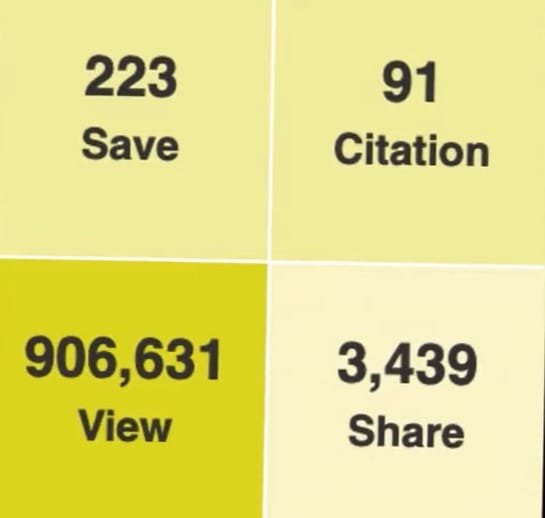Altmetric stands for “alternative metrics,” and it differs from traditional metrics like citizen count and H-index. The term “altmetric” was formally introduced by Jones Prime in 2010. Altmetric provides an immediate overview of an article on research topics when the content is available in accessible online versions. It tracks social media presence on platforms such as Facebook, Twitter, LinkedIn, and blogs, as well as counting views, downloads, online readings, and mentions of emerging trends.
Altmetric follows traditional metrics, including citation counts from Scopus, Web of Science, PubMed, and Google Scholar. Altmetric is a tool that monitors the online engagement and impact of academic research across various platforms beyond conventional academic citations.

Its primary functions include:
1. Tracking Online Mentions and Engagement: Altmetric monitors a wide range of sources, including social media (e.g., Twitter, Facebook), news outlets, policy documents, blogs, patent mentions, and online platforms (such as Reddit and YouTube) for references to research papers and other scholarly outputs. This allows researchers and institutions to see how much attention their work receives outside traditional academic channels.
2. Aggregating Impact Data: Altmetric provides a summary known as the “Altmetric Attention Score,” which is a weighted score indicating the level and variety of attention a specific research output has received. The score is based on factors like the mention’s source, frequency, and nature of engagement.
3. Providing Visual Insights: Altmetric features a visual “donut” badge, with different colors representing various platforms or types of attention. This design enables users to quickly understand where the engagement is coming from.
4. Supplementing Traditional Metrics: While traditional citation-based metrics take time to accumulate, Altmetric captures real-time indicators of attention, helping researchers and institutions assess the immediate impact of their work on a broader audience.
5. Analyzing Societal Impact: Altmetric data helps evaluate the broader societal impact of research by illustrating where it is being discussed and applied outside academic circles. This information is valuable for funders, policymakers, and institutions interested in the societal relevance of research outputs.
Overall, Altmetric assists researchers, institutions, and funders in understanding how research findings are communicated, applied, and valued in real-world contexts beyond the realm of academia.
Altmetric data is becoming increasingly important in research because it provides a more comprehensive view of the impact and reach of scholarly work.
Here are several key reasons why Altmetric is valuable in research contexts:
a)Broader Impact Assessment:
Altmetric captures the immediate online attention that research receives, offering insights into how it resonates with both academic and public audiences. This is particularly useful in fields where societal engagement or policy influence is relevant, as Altmetric data shows how research is reaching practitioners, policymakers, journalists, and the general public.
b)Real-Time Feedback:
Traditional academic metrics, like citations, can take months or even years to accumulate, while Altmetric data provides real-time feedback. This allows researchers to see the immediate response to their work, enabling timely engagement with those interested in their findings.
c) Engagement beyond Academia:
Altmetric tracks mentions across non-academic sources such as news media, social media, government documents, and blogs, providing insights into how research is discussed and applied in broader contexts. This is especially valuable for public health, environmental, or policy-related research, where influence on public discourse and policy is significant.
d) Enhanced visibility and networking:
By tracking where and by whom research is being discussed, Altmetric helps researchers identify potential collaborators, influencers, or stakeholders interested in their work. Engaging with these individuals or groups can open doors for future research opportunities, outreach, and knowledge dissemination.
e) Supporting Funding Applications:
For funding agencies and institutions that are increasingly interested in research impact, Altmetric data can serve as evidence of societal relevance and outreach. This demonstrates that the research contributes not only to academic knowledge but also has an impact on the wider world.
f) Tracking Public Interest and Misinterpretation:
By monitoring online mentions, Altmetric can help researchers identify any misinterpretations or misuses of their findings in public discussions. This is crucial for clarifying misunderstandings or addressing misinformation.
g) Encouraging Knowledge Translation and Outreach:
Altmetric encourages researchers to consider knowledge translation and engagement as part of their work. Knowing that their research impact is visible can inspire researchers to communicate their findings more broadly and effectively.
There are three platforms used to measure Altmetric’s impact:
1. Altmetric.com:
Altmetric.com is a platform that assesses the online impact of research by tracking and analyzing mentions from various sources, including news outlets, social media, policy documents, and blogs. It generates an “Altmetric Attention Score” for each research output, providing a quick indicator of the volume and reach of online engagement. This score, along with its detailed breakdown, helps researchers and institutions understand how their work resonates with audiences beyond traditional academic channels, highlighting its broader societal and public influence.

2. PlumX Metrics:
PlumX Metrics is an altmetric tool that offers insights into research impact by tracking different types of online engagement, such as usage, captures, mentions, social media interactions, and citations. Each of these five categories is represented on PlumX’s metrics dashboard, providing a comprehensive view of a research work’s reach and influence across digital platforms. By aggregating these diverse metrics, PlumX helps researchers, institutions, and funders understand the broader impact of research in real time and across multiple contexts beyond conventional academic citations.

This image represents the five main categories of PlumX Metrics, a tool that measures the impact of research through various online engagements. Each category tracks a different type of interaction: Usage (e.g., clicks, views, downloads), Captures (e.g., bookmarks, reference manager saves), Mentions (e.g., blog posts, news mentions), Social Media (e.g., likes, shares, tweets), and Citations (e.g., patent and policy citations). Together, these metrics provide a holistic view of how research is used, discussed, saved, and referenced across multiple online platforms.
3. PLOS ONE Metrics:
PLOS ONE Metrics provides a comprehensive view of research impact by monitoring both traditional and alternative metrics for articles published in PLOS journals. These metrics include article-level data on views, downloads, citations, and social media engagement, which collectively capture a broad picture of the research’s influence across various platforms. Through this real-time tracking, PLOS ONE Metrics helps authors and readers assess how research is being accessed, discussed, and applied within both academic and public spheres.

This image shows PLOS ONE Metrics, which provides different indicators of research engagement. The metrics include saves (223), showing how many times the article was saved or bookmarked; citations (91), indicating the number of academic references to the work; views (906,631), representing the total number of times the article was viewed; and shares (3,439), reflecting the frequency of the article being shared on social media platforms. Together, these metrics help gauge the article’s popularity, academic impact, and social reach.
Platforms for measuring Altmetrics include Altmetric.com, which monitors online mentions and social engagement across various sources, such as social media, policy documents, and news outlets. It assigns an Altmetric Attention Score to quantify the impact of research. PlumX Metrics breaks down impact into five key areas: usage, captures, mentions, social media, and citations, offering a comprehensive view of research influence. PLOS ONE Metrics specifically tracks engagement with PLOS articles, including views, downloads, and social media mentions, providing insights into how research resonates with both academic and broader audiences.
In summary, Altmetric data enriches our understanding of research impact by offering an expanded view beyond academic citations. It highlights the relevance, influence, and reach of research in society.



